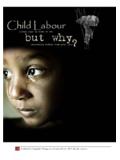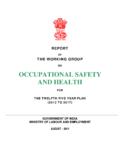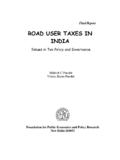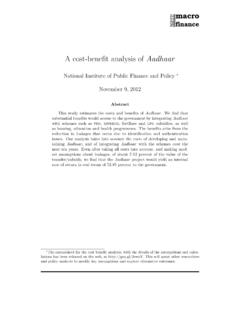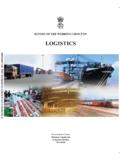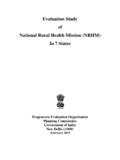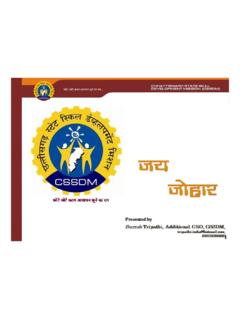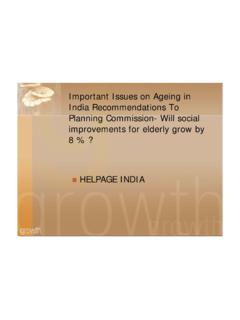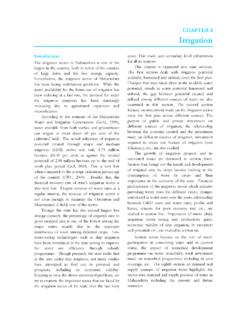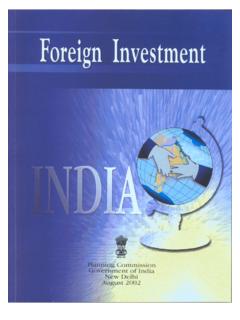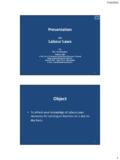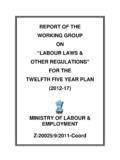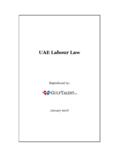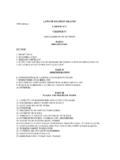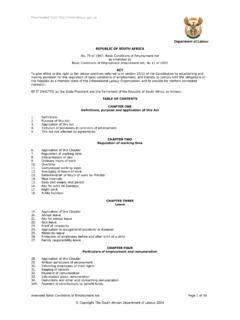Transcription of Labour Laws And Other Labour Regulations
1 1 Report of the Working Group on Labour laws And Other Labour Regulations Government of India Planning Commission New Delhi PREFACE 2 In the context of preparation of the Eleventh Five Year Plan (2007-2012), the Planning Commission set up a Working Group on Labour laws and Other Labour Regulations under the Chairmanship of Secretary, Ministry of Labour & Employment, Government of India, laying down the terms of reference. The subject basically relates to Labour law reforms. It is a dynamic and continuous subject, evolving over time. The Report touches upon the historical background, nature and classification of various Labour laws and steps already taken and being desired so that our Labour laws are in conformity with changing socio-economic scenario. The basic purpose being to promote interests of all stake holders and arriving at a consensus in the matter, we have immensely benefited from the interactions we had with them in various fora , including the deliberations in this Meeting of the Working Group.
2 The Report tries to put in place the diverse views and at the same time show the path ahead by way of making certain useful recommendations. It is hoped that these would provide valuable input to the formulation of the Eleventh Five Year Plan. ,, I immensely appreciate the sincere efforts put in by the Convener of the Working Group Dr. Ashok Sahu, Economic Adviser, Dr. Harcharan Singh, Director and Officers and Staff of Coordination Section of the Ministry of Labour & Employment, who were instrumental in organizing meetings and preparing the report. I would like to convey my sincere thanks to all the Members of the Working Group for their fullest cooperation in handling such a complex subject of Labour law reforms having wide-ranging ramifications on work force, trade industry as well as the economy.
3 ( Sahni ) Secretary Ministry of Labour & Employment 3 REPORT OF THE WORKING GROUP ON Labour laws AND Other Labour Regulations ** ** I. Introduction The Planning Commission, vide its Order No. U-20017/01/2005-LEM/LP dated notified the constitution of one Steering Group for Labour and Employment under the Chairmanship of Prof. Mungekar and six following Working Groups :- Working Group Chairman i) Labour Force and Employment Projection Member (LEM) Planning Commission ii) Skill Development and Vocational Training Secretary, Labour & Employment iii) Labour laws and Other Labour Regulations Secretary, Labour & Employment iv) Social Security Secretary, Labour & Employment v) Child Labour Secretary, Labour & Employment vi)
4 Occupational Health and Safety Secretary, Labour & Employment The Working Group on Labour laws and Other Labour Regulations was constituted by Planning Commission, vide its Order No U-20017/01/2005-LEM/LP dated The composition and the terms of reference of the Working Group is enclosed as Annexure-I. As per Para 4 of the Order constituting the Working Group on Labour laws and Other Labour Regulations , the Chairman of the Working Group may co-opt any Other expert as Member of the Group. The representatives of Hind Mazdoor Sabha, National Commission for Enterprises in the Unorganized Sector and Labour Commissioner, Government of Uttar Pradesh were co-opted in the Group. 4 The meeting of the Working Group on Labour laws and Labour Regulations was held under the Chairmanship of Secretary (L&E) on 8th August, 2006.
5 The Group discussed in details the Terms of Reference and issues related to amendments of Labour laws , simplifications and Other Labour Regulations . The Principal Adviser, Planning Commission offered certain suggestion relating to the Minimum Wages Act, 1948, the Industrial Disputes Act, 1947, the Employees State Insurance Act, 1948 and the Employees Provident Fund and Miscellaneous Provisions Act, 1952 for being considered by the Working Group Meeting. His letter enclosed as Annexure-II was made part of the Agenda Note for the Meeting of the Working Group. This report is based on the discussions held by the Working Group. A copy of the Minutes of the meeting is enclosed as Annexure-III. 5 2. Historical Background of Labour Policy & Labour laws India s Labour Policy is mainly based on Labour laws .
6 The Labour laws of independent India derive their origin, inspiration and strength partly from the views expressed by important nationalist leaders during the days of national freedom struggle, partly from the debates of the Constituent Assembly and partly from the provisions of the Constitution and the International Conventions and Recommendations. The relevance of the dignity of human Labour and the need for protecting and safeguarding the interest of Labour as human beings has been enshrined in Chapter-III (Articles 16, 19, 23 & 24) and Chapter IV (Articles 39, 41, 42, 43, 43A & 54) of the Constitution of India keeping in line with Fundamental Rights and Directive Principles of State Policy. The Labour laws were also influenced by important human rights and the conventions and standards that have emerged from the United Nations.
7 These include right to work of one s choice, right against discrimination, prohibition of child Labour , just and humane conditions of work, social security, protection of wages, redress of grievances, right to organize and form trade unions, collective bargaining and participation in management. Our Labour laws have also been significantly influenced by the deliberations of the various Sessions of the Indian Labour Conference and the International Labour Conference. Labour legislations have also been shaped and influenced by the recommendations of the various National Committees and Commissions such as First National Commission on Labour (1969) under the Chairmanship of Justice Gajendragadkar, National Commission on Rural Labour (1991), Second National Commission on Labour ( 2002) under the Chairmanship of Shri Ravindra Varma etc.
8 And judicial pronouncements on Labour related matters specifically pertaining to minimum wages, bonded Labour , child Labour , contract Labour etc. 63. Constitutional Framework Under the Constitution of India, Labour is a subject in the concurrent list where both the Central and State Governments are competent to enact legislations. As a result , a large number of Labour laws have been enacted catering to different aspects of Labour namely, occupational health, safety, employment, training of apprentices, fixation, review and revision of minimum wages, mode of payment of wages, payment of compensation to workmen who suffer injuries as a result of accidents or causing death or disablement, bonded Labour , contract Labour , women Labour and child Labour , resolution and adjudication of industrial disputes, provision of social security such as provident fund, employees state insurance, gratuity, provision for payment of bonus, regulating the working conditions of certain specific categories of workmen such as plantation Labour , beedi workers etc.
9 This is how we have a large number of Labour legislations, which can be categorized as follows: Sl. No. Name of the Act (a) Labour laws enacted by the Central Government, where the Central Government has the sole responsibility for enforcement 1. The Employees State Insurance Act, 1948 2. The Employees Provident Fund and Miscellaneous Provisions Act, 1952 3. The Dock Workers (Safety, Health and Welfare) Act, 1986 4. The Mines Act, 1952 5. The Iron Ore Mines, Manganese Ore Mines and Chrome Ore Mines Labour Welfare (Cess) Act, 1976 6. The Iron Ore Mines, Manganese Ore Mines and Chrome Ore Mines Labor Welfare Fund Act, 1976 7. The Mica Mines Labour Welfare Fund Act, 1946 8. The Beedi Workers Welfare Cess Act, 1976 9. The Limestone and Dolomite Mines Labour Welfare Fund Act, 1972 10. The Cine Workers Welfare (Cess) Act, 1981 11. The Beedi Workers Welfare Fund Act, 1976 12.
10 The Cine Workers Welfare Fund Act, 1981 7(b) Labour laws enacted by Central Government and enforced both by Central and State Governments 13. The Child Labour (Prohibition and Regulation) Act, 1986. 14. The Building and Other Constructions Workers (Regulation of Employment and Conditions of Service) Act, 1996. 15. The Contract Labour (Regulation and Abolition) Act, 1970. 16. The Equal Remuneration Act, 1976. 17. The Industrial Disputes Act, 1947. 18 The Industrial Employment (Standing Orders) Act, 1946. 19. The Inter-State Migrant Workmen (Regulation of Employment and Conditions of Service) Act, 1979. 20. The Labour laws (Exemption from Furnishing Returns and Maintaining Registers by Certain Establishments) Act, 1988 21. The Maternity Benefit Act, 1961 22. The Minimum Wages Act, 1948 23. The Payment of Bonus Act, 1965 24.
